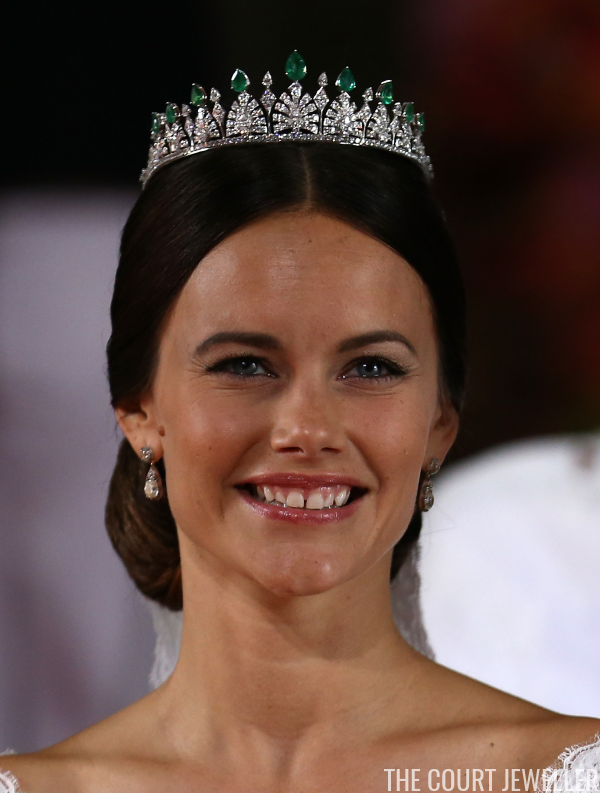 |
| Princess Sofia wears her wedding tiara (Photo: Andreas Rentz/Getty Images) |
The Swedish Four Button Tiara
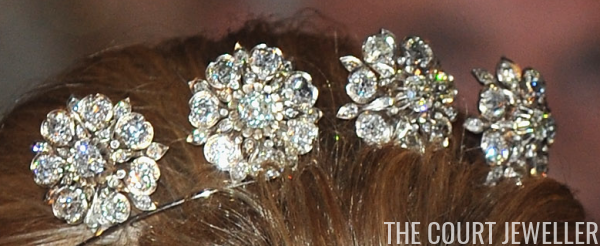 |
| The Swedish Four Button Tiara (Photo: Pascal Le Segretain/Getty Images) |
The Bernadottes of Sweden have two significant tiaras made of round diamond “button” elements placed on rather simple tiara frames. One of the tiaras has six buttons, and the other has four. Today, we’re taking a closer look at the Four Button Tiara.
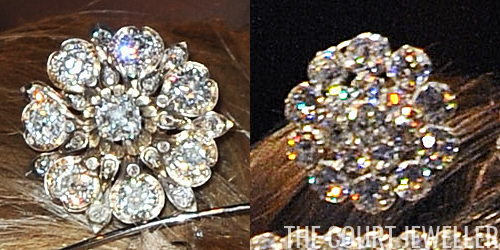 |
| Left: the Four Button Tiara; Right: the Six Button Tiara (Photos: Pascal Le Segretain/Getty Images) |
The buttons on the tiaras look extremely similar, especially from a distance, but each tiara features a different kind of floral button. The six button elements are rosettes, featuring ten small round diamonds hugging a larger floral cluster of seven additional diamonds. The four button elements are more complex (and, I think, more beautiful); they feature seven round diamonds encircling a central diamond in a sunburst design. The edges of the buttons include tiny diamond “leaves” between the “petals,” making the buttons look a little bit like Tudor roses.
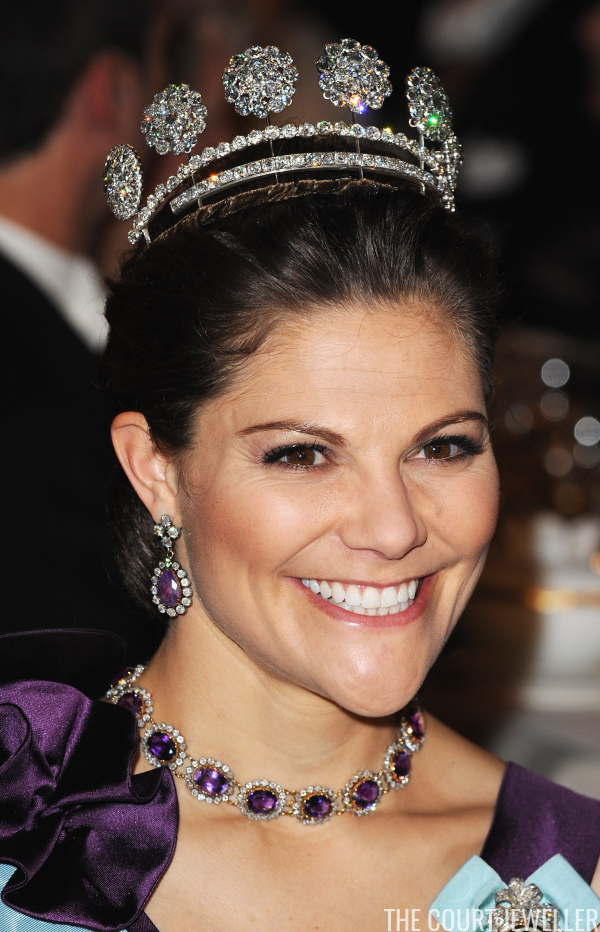 |
| Crown Princess Victoria wears the Six Button Tiara (Photo: Pascal Le Segretain/Getty Images) |
While the Swedish royals have an array of heirloom jewels with impressive provenances, these buttons are possibly some of the most significant ornaments in their collection. We know where the diamond rosettes from the Six Button Tiara originated: the Swedish royal court has confirmed that the buttons from the Six Button Tiara are the same “diamond rosettes” that were attached to the crown worn by King Carl XIV Johan, who was born Jean Baptiste Bernadotte, at his coronation in 1818.
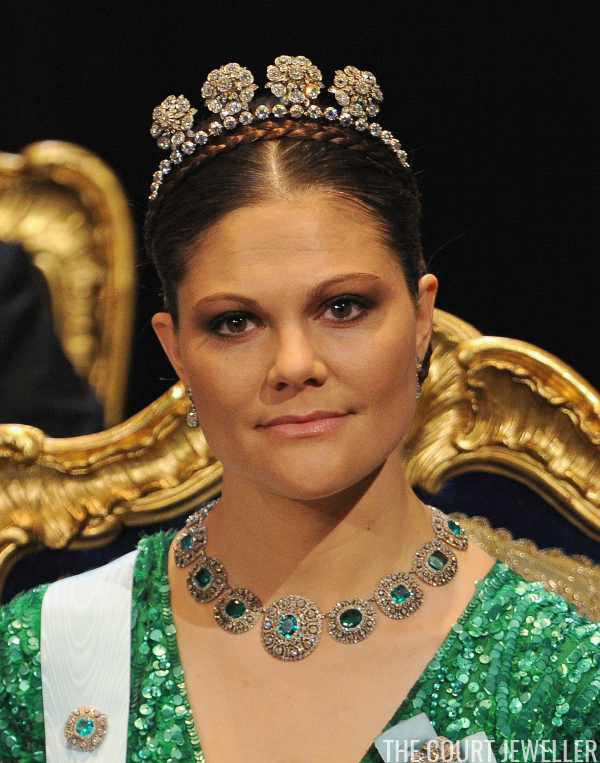 |
| Crown Princess Victoria wears the Four Button Tiara (Photo: Pascal Le Segretain/Getty Images) |
The Four Button Tiara’s ornaments, however, have a less clear provenance. One theory suggests that the buttons also first belonged to King Carl XIV Johan. He was a Maréchal d’Empire under Napoleon I in France, and some have speculated that these buttons may have adorned his gala uniform. The other theory on the origin of these buttons suggests that they originated not in France but with an even older generation of Swedish royals. Queen Louisa Ulrika, who was the consort of King Adolf Fredrik, had a set of diamond buttons that she wore in her hair; she also had a stomacher that included elements similar to the tiara’s buttons.
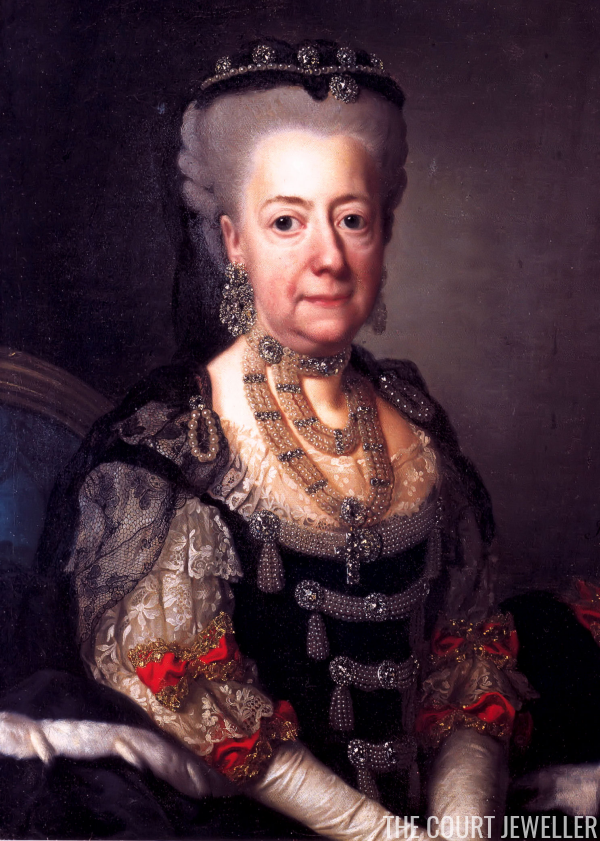 |
| Queen Louisa Ulrika of Sweden (Image: Wikimedia Commons) |
Here’s a portrait that shows her wearing some of these pieces. If these are the same ornaments worn by Louisa Ulrika, that would mean they were created at some point in the middle of the eighteenth century, and it would also mean that they’re rare examples of jewels in the current Swedish royal collection that pre-date the Bernadotte dynasty.
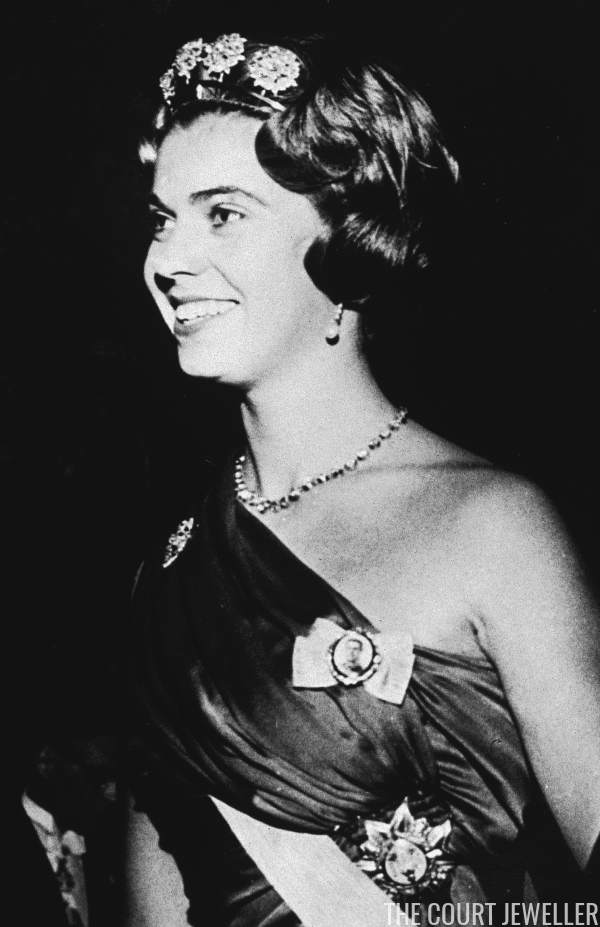 |
| Princess Margaretha wears the Four Button Tiara (Photo: Express Newspapers/Getty Images) |
While the buttons themselves are antique, both tiaras are apparently twentieth-century creations. The current king’s sisters began wearing the Four Button Tiara in the 1950s. Above, you see Princess Margaretha wearing the tiara at the Nobel Prize ceremony in 1959.
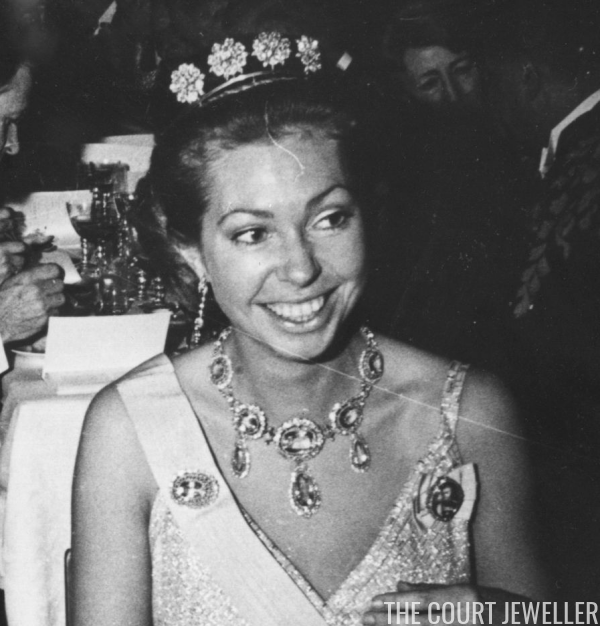 |
| Princess Christina wears the Four Button Tiara (Photo: Central Press/Getty Images) |
And here’s Princess Christina, the youngest of the Haga princesses, wearing the Four Button with the family’s magnificent pink topaz suite at the Nobels in 1970.
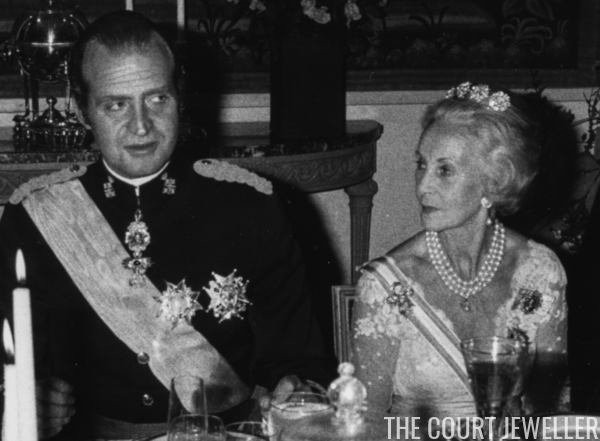 |
| Princess Lilian wears the Four Button Tiara (Photo: Keystone/Hulton Archive/Getty Images) |
The Six Button was apparently assembled later on for the use of the late Princess Lilian, but she also wore the Four Button. Above, she dons the tiara during the Spanish state visit to Sweden in 1979. The Six Button is a more elaborate piece overall; the Four Button has a much simpler frame, and it sits lower on the wearer’s head. Occasionally the base is supplemented by an extra row of diamonds.
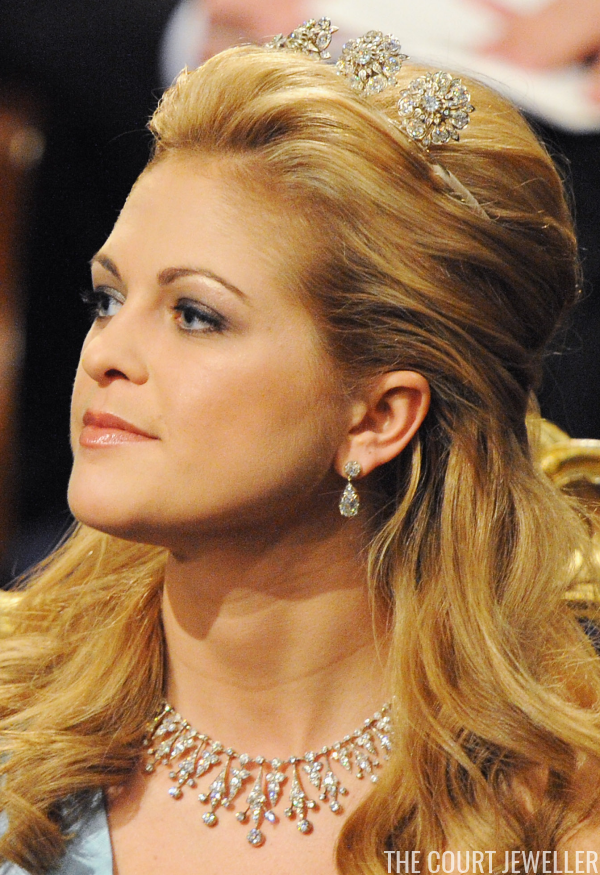 |
| Princess Madeleine wears the Four Button Tiara (Photo: Pascal Le Segretain/Getty Images) |
Both of the button diadems tend to be some of the more controversial sparklers in the Swedish jewel foundation among royal jewel lovers; I’ll admit that I’ve been guilty of calling the Four Button the “Jeep” tiara more than once in the past! The Four Button in particular is generally used by the more junior members of the family. (To my knowledge, Queen Silvia has never been photographed in the Four Button.) Today, Victoria and Madeleine are the usual wearers of the Four Button Tiara, but I think this is also a good candidate for Princess Sofia when she finally starts delving into the Bernadotte tiara stash. (Which will hopefully be soon!)
Jewel History: Gifts for Princess Bride (1905)
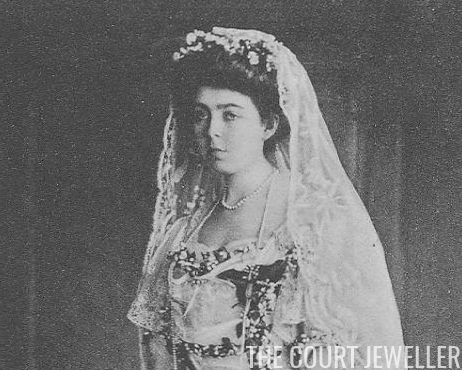 |
| Margaret of Connaught on her wedding day (Photo: Grand Ladies Site) |
London, June 10 — With the departure of King Alfonso [1], interest in society circles begins to center on the coming wedding of Prince Gustaf Adolf [2], eldest son of Crown Prince Gustaf of Sweden and Norway, and Princess Margaret Victoria [3], daughter of the Duke of Connaught, to which unusual attention is drawn by the present crisis between Norway and Sweden [4].
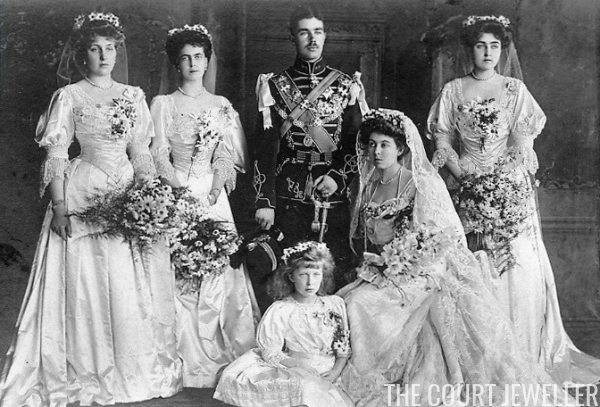 |
| The wedding party: (L-R) Victoria Eugenie of Battenberg (later Queen Ena of Spain); Princess Beatrice of Saxe-Coburg and Gotha (later Duchess of Galliera and Infanta of Spain); Prince Gustaf Adolf of Sweden (later King Gustaf VI Adolf of Sweden); Princess Mary of Wales (later Princess Royal and Countess of Harewood); Princess Margaret of Connaught (later Crown Princess Margareta of Sweden); Princess Patricia of Connaught (later Lady Patricia Ramsay) (Photo: Grand Ladies Site) |
The wedding dress is a cloud of pure white Irish lace, posed over white satin and strewn with garlands of orange blossoms and myrtles. The corsage is cut low, and there is the regulation court train. This is a confection from Paris, but practically all other dresses for the bride and bridesmaids are of British or Irish make and material.
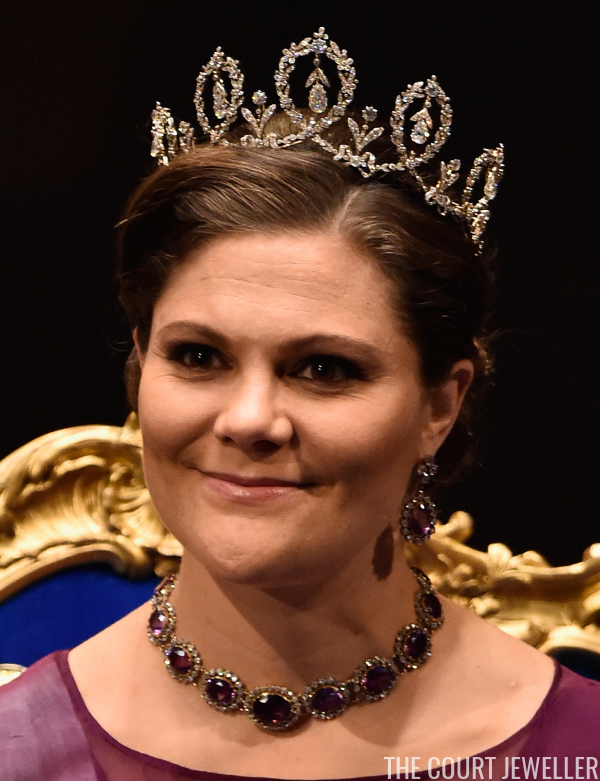 |
| Crown Princess Victoria of Sweden, Margaret’s great-granddaughter, wears the Connaught Diamond Tiara in December 2015 (Photo: Pascal Le Segretain/Getty Images) |
The Duke and Duchess of Connaught gave a garden party at Clarence House yesterday for the display of the magnificent wedding gifts, which formed an amazing display of jewelry, especially rubies, Princess Margaret Victoria’s favorite gem. The Duke and Duchess of Connaught gave their daughter a diamond tiara [5] and a sable coat.
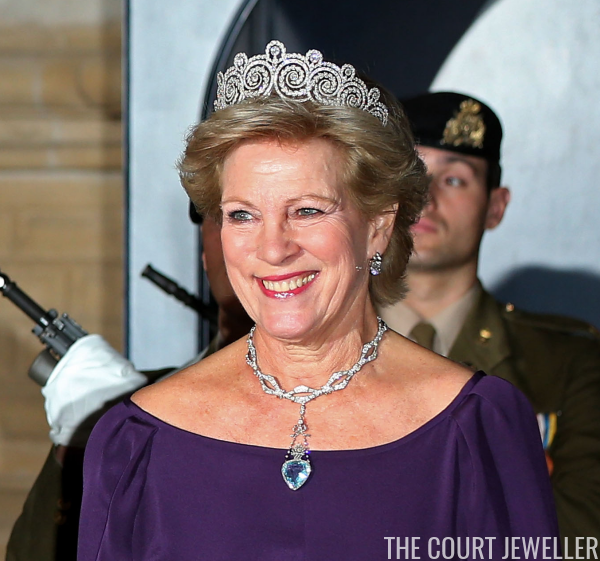 |
| Anne-Marie of Greece, Margaret’s granddaughter, wears the Khedive of Egypt Tiara in October 2012 (Photo: Sean Gallup/Getty Images) |
King Edward and Queen Alexandra gave a magnificent tiara of rubies and diamonds [6], while a beautiful necklace of rubies and diamonds [7] is the joint gift of the Prince and Princess of Wales, Princess Louise and the Duke of Fife, Princess Victoria, and Prince and Princess Charles of Denmark [8]. The Khedive of Egypt sent a diamond tiara [9].
NOTES
1. King Alfonso XIII of Spain (1886-1941) made a state visit to the UK in June 1905, just before this article was published. He was hosted at Buckingham Palace by King Edward VII. Royal matchmakers had hoped that the young Spanish king would catch the eye of Princess Patricia of Connaught, one of Edward VII’s nieces (and one of the most eligible princesses in the country). Instead, Alfonso met Princess Ena of Battenberg, another of the British king’s nieces. Alfonso and Ena married the following year.
2. Gustaf Adolf of Sweden (1882-1973), the grandson of King Oscar II of Sweden. Gustaf Adolf was the son of Crown Prince Gustaf of Sweden and his wife, Victoria of Baden. He ascended to the throne as King Gustaf VI Adolf of Sweden in 1950. Just like Alfonso, Gustaf Adolf had originally been targeted as a bride for Princess Patricia; instead, he fell in love with her elder sister, Princess Margaret.
3. Margaret of Connaught (1882-1920) was the elder daughter of the Duke and Duchess of Connaught (and therefore a granddaughter of Queen Victoria). She married Sweden’s future king in 1905, and two years later, she became the country’s crown princess. While heavily pregnant with her sixth child, Margaret died in 1920 of an infection following an operation. Today, two of her grandchildren are reigning European monarchs: King Carl XVI Gustaf of Sweden and Queen Margarethe II of Denmark.
4. In June 1905, Sweden and Norway were a part of a personal union of countries under a single monarch (King Oscar II of Sweden and Norway). In August 1905, the people of Norway voted almost unanimously to dissolve the union and become a fully independent nation. The Norwegians initially offered to let one of Oscar II’s younger sons become their new monarch; the diplomatic move was called the “Bernadotte offer.” After the offer was rejected, Norway’s parliament ultimately selected Prince Carl, a younger son of Denmark’s king, as their new monarch. Carl was married to Princess Maud of Wales, a daughter of King Edward VII of the United Kingdom. They were crowned King Haakon VII and Queen Maud of Norway in June 1906.
5. The Connaught Diamond Tiara, a wedding gift from Margaret’s parents, was made by E. Wolff and Co. in 1904; today, the tiara is owned by Margaret’s grandson, King Carl XVI Gustaf of Sweden.
6. The King Edward VII Ruby Tiara, Margaret’s wedding gift from her uncle and aunt, is owned today by her grandson, King Carl XVI Gustaf of Sweden, but there were several controversial sales of the piece within the family during the twentieth century.
7. This necklace of rubies and diamonds was made to coordinate with the King Edward VII Ruby Tiara. It was sold, and its whereabouts are not known.
8. The necklace was a gift from the children of King Edward VII and Queen Alexandra and their spouses. The Prince and Princess of Wales were the future King George V and Queen Mary of the United Kingdom; Prince and Princess Charles of Denmark were the future King Haakon VII and Queen Maud of Norway (see note #4).
9. The Khedive of Egypt gave Margaret a magnificent diamond tiara from Cartier; the gift was especially significant because Gustaf Adolf and Margaret fell in love and became engaged in Egypt. Today, the tiara is owned by Margaret’s granddaughter, Anne-Marie, the former Queen of Greece. It has become the official wedding tiara of all of Margaret’s female-line descendants.
- « Previous Page
- 1
- …
- 194
- 195
- 196
- 197
- 198
- …
- 276
- Next Page »